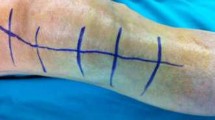Abstract
Periprosthetic fractures around the knee after arthroplasty represent a dramatic cause of revision, and their incidence is likely to rise in the next years as the number of Total Knee Arthroplasties will continue to increase. Our brief overview supports the fact that functional outcomes after periprosthetic fractures significantly decrease compared to the preinjury status, with a significant reduction in the mobility of patients. The treatment of periprosthetic knee fractures is extremely challenging and goes from a conservative treatment to open reduction and fixation and, finally, to implant of a megaprosthesis. Decision-making regarding the most appropriate treatment should be made on an individual basis depending on the location of fractures, stability of the components, and the age and functional requests of patients.


Similar content being viewed by others
Bibliografia
Callahan CM, Drake BG, Heck DA et al. (1994) Patient outcomes following tricompartmental total knee replacement. A metaanalysis. JAMA 271:1349–1357
Maloney WJ (2001) National Joint Replacement Registries: has the time come? J Bone Jt Surg, Am 83:1582–1585
Kurtz SM, Lau E, Ong K et al. (2009) Future young patient demand for primary and revision joint replacement: national projections from 2010 to 2030. Clin Orthop Relat Res 467:2606–2612
Sharkey PF, Hozack WJ, Rothman RH et al. (2002) Insall Award paper. Why are total knee arthroplasties failing today? Clin Orthop Relat Res 404:7–13
Hoffmann MF, Jones CB, Sietsema DL et al. (2012) Outcome of periprosthetic distal femoral fractures following knee arthroplasty. Injury 43:1084–1089
Craig DV (2008) Periprosthetic fractures around total hip and total knee replacements: a problem on the rise but better solutions. In: 75th AAOS annual meeting, March 15
McGraw P Kumar A (2010) Periprosthetic fractures of the femur after total knee arthroplasty. J Orthop Traumatol 11:135–141
Della Rocca GJ (2013) Periprosthetic fractures about the knee—an overview. J Knee Surg 26:3–7
Giannelli Buccioni L, Carulli C, Guerri S et al. (2015) Le fratture periprotesiche di ginocchio: una problematica emergente. GIOT 41:128–136
Kim KI, Egol KA, Hozack WJ et al. (2006) Periprosthetic fractures after total knee arthroplasties. Clin Orthop Relat Res 446:167–175
Herrera DA, Kregor PJ, Cole PA et al. (2008) Treatment of acute distal femur fractures above a total knee arthroplasty: systematic review of 415 cases (1981–2006). Acta Orthop 79:22–27
Rorabeck CH, Taylor JW (1999) Classification of periprosthetic fractures complicating total knee arthroplasty. Orthop Clin N Am 30:209–214
Singh JA, Jensen M, Lewallen D (2013) Predictors of periprosthetic fracture after total knee replacement: an analysis of 21,723 cases. Acta Orthop 84:170–177
Chalidis BE, Tsiridis E, Tragas AA et al. (2007) Management of periprosthetic patellar fractures. A systematic review of literature. Injury 38:714–724
Lizaur-Utrilla A, Miralles-Muñoz FA, Sanz-Reig J (2013) Functional outcome of total knee arthroplasty after periprosthetic distal femoral fracture. J Arthroplast 28:1585–1588
Sochart DH, Hardinge K (1997) Nonsurgical management of supracondylar fracture above total knee arthroplasty. Still the nineties option. J Arthroplast 12:830–834
Saidi K, Ben-Lulu O, Tsuji M et al. (2014) Supracondylar periprosthetic fractures of the knee in the elderly patients: a comparison of treatment using allograft-implant composites, standard revision components, distal femoral replacement prosthesis. J Arthroplast 29:110–114
Ricci WM, Loftus T, Cox C et al. (2006) Locked plates combined with minimally invasive insertion technique for the treatment of periprosthetic supracondylar femur fractures above a total knee arthroplasty. J Orthop Trauma 20:190–196
Bong MR, Egol KA, Koval KJ et al. (2002) Comparison of the LISS and a retrograde-inserted supracondylar intramedullary nail for fixation of a periprosthetic distal femur fracture proximal to a total knee arthroplasty. J Arthroplast 17:876–881
Lundh F, Sayed-Noor AS, Brosjö O et al. (2014) Megaprosthetic reconstruction for periprosthetic or highly comminuted fractures of the hip and knee. Eur J Orthop Surg Traumatol 24:553–557
Ritter MA, Thong AE, Keating EM et al. (2005) The effect of femoral notching during total knee arthroplasty on the prevalence of postoperative femoral fractures and on clinical outcome. J Bone Jt Surg, Am 87:2411–2414
Kusuma SK, Puri N, Lotke PA (2009) Lateral retinacular release during primary total knee arthroplasty: effect on outcomes and complications. J Arthroplast 24:383–390
Author information
Authors and Affiliations
Corresponding author
Ethics declarations
Conflitto di interesse e conformità agli standard etici
Gli autori Tommaso Melani, Giacomo Sani, Christian Carulli e Massimo Innocenti dichiarano di non aver alcun conflitto di interesse.
Consenso informato e conformità agli standard etici
Tutte le procedure descritte nello studio e che hanno coinvolto esseri umani sono state attuate in conformità alle norme etiche stabilite dalla dichiarazione di Helsinki del 1975 e successive modifiche. Il consenso informato è stato ottenuto da tutti i pazienti inclusi nello studio.
Human and Animal Rights
L’articolo non contiene alcuno studio eseguito su esseri umani e su animali da parte degli autori.
Rights and permissions
About this article
Cite this article
Melani, T., Sani, G., Carulli, C. et al. Attualità sulle fratture periprotesiche di ginocchio. LO SCALPELLO 32, 56–59 (2018). https://doi.org/10.1007/s11639-018-0259-7
Published:
Issue Date:
DOI: https://doi.org/10.1007/s11639-018-0259-7




